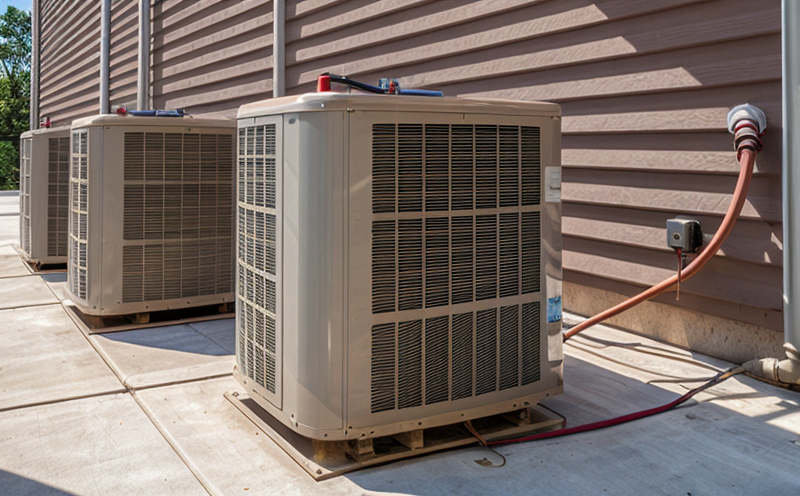ASHRAE 100 Energy Efficiency Testing of Buildings
The ASHRAE Standard 100-2019 establishes a comprehensive approach to energy efficiency testing in buildings. This standard is widely recognized for its rigorous methodologies and stringent criteria, making it an essential tool for quality managers, compliance officers, R&D engineers, and procurement professionals. The test focuses on evaluating the overall building performance with respect to HVAC systems, lighting, and other energy-consuming components.
The ASHRAE 100 protocol is designed to ensure that buildings meet or exceed specified levels of energy efficiency as defined in the standard. It provides a framework for conducting detailed tests to identify areas where energy consumption can be reduced without compromising occupant comfort. The testing process involves multiple stages, including initial baseline measurement, field testing, data collection, and analysis.
The first step is to establish a reliable baseline by measuring current energy usage against ASHRAE 100 criteria. This requires accurate instrumentation and a clear understanding of the building's operational parameters. Once the baseline has been established, various tests are conducted on different systems within the building—such as HVAC units, lighting fixtures, and control systems—to evaluate their efficiency.
Data collected during these tests is then analyzed to identify discrepancies between expected performance levels and actual measurements. Based on this analysis, recommendations for improvements can be made to enhance overall energy efficiency. Compliance with ASHRAE 100 ensures that buildings meet or exceed minimum requirements set forth by the standard, thereby promoting sustainable practices across various industries.
By adhering to these guidelines, organizations demonstrate their commitment to environmental responsibility while also potentially reducing operational costs associated with heating and cooling systems. For those seeking certification under ASHRAE 100, thorough documentation of all testing procedures and results is required along with periodic re-evaluation every five years.
Our team specializes in providing comprehensive services that encompass not only the technical aspects but also ensuring full compliance throughout the entire process. With our expertise and state-of-the-art facilities, we offer reliable solutions tailored specifically for your unique needs.
Scope and Methodology
The ASHRAE 100-2019 standard defines specific procedures for conducting energy efficiency tests on buildings. These guidelines cover a wide range of topics including but not limited to HVAC systems, lighting fixtures, and control strategies. The scope includes:
- Baseline energy consumption measurement
- Field testing under real-world conditions
- Data collection and analysis
- Routine maintenance recommendations
- Compliance verification through periodic re-assessment every five years
The methodology employed follows internationally recognized standards such as ISO 5004-2:2016, which provides additional context on best practices for energy management in buildings. Our experienced technicians ensure that all tests are conducted according to these stringent requirements.
Benefits
The primary benefit of conducting ASHRAE 100 energy efficiency testing lies in its ability to optimize building performance while reducing operational costs. By identifying inefficiencies early on, organizations can take proactive measures to improve their systems before they lead to significant financial losses.
- Reduces utility bills
- Promotes sustainable practices
- Enhances occupant comfort and satisfaction
- Ensures regulatory compliance
- Achieves certification under ASHRAE 100
In addition to cost savings, there are numerous environmental advantages associated with this type of testing. For instance, by minimizing energy consumption, buildings contribute less greenhouse gas emissions into the atmosphere. This aligns perfectly with global efforts towards combating climate change.
Furthermore, achieving certification under ASHRAE 100 can enhance an organization's reputation in the marketplace, attracting more customers and partners who value sustainability initiatives. It also opens up opportunities for participation in government programs aimed at promoting green buildings.
Competitive Advantage and Market Impact
Adhering to ASHRAE 100 not only brings tangible benefits but also provides a strong competitive edge in today’s market. Here are some key points highlighting how compliance can impact business operations:
- Maintains regulatory compliance, avoiding potential fines or penalties.
- Increases brand value and customer trust through commitment to sustainability.
- Promotes innovation by encouraging continuous improvement of energy-efficient practices.
- Attracts investment from environmentally conscious stakeholders looking for long-term partners committed to green initiatives.
- Fosters collaboration between industry leaders, researchers, and policymakers focused on advancing sustainable solutions.
As environmental awareness continues to grow globally, organizations that prioritize energy efficiency will find themselves better positioned against competitors who are slower to adopt similar practices. This strategic approach allows companies to stay ahead of changing market trends while contributing positively towards societal goals.





